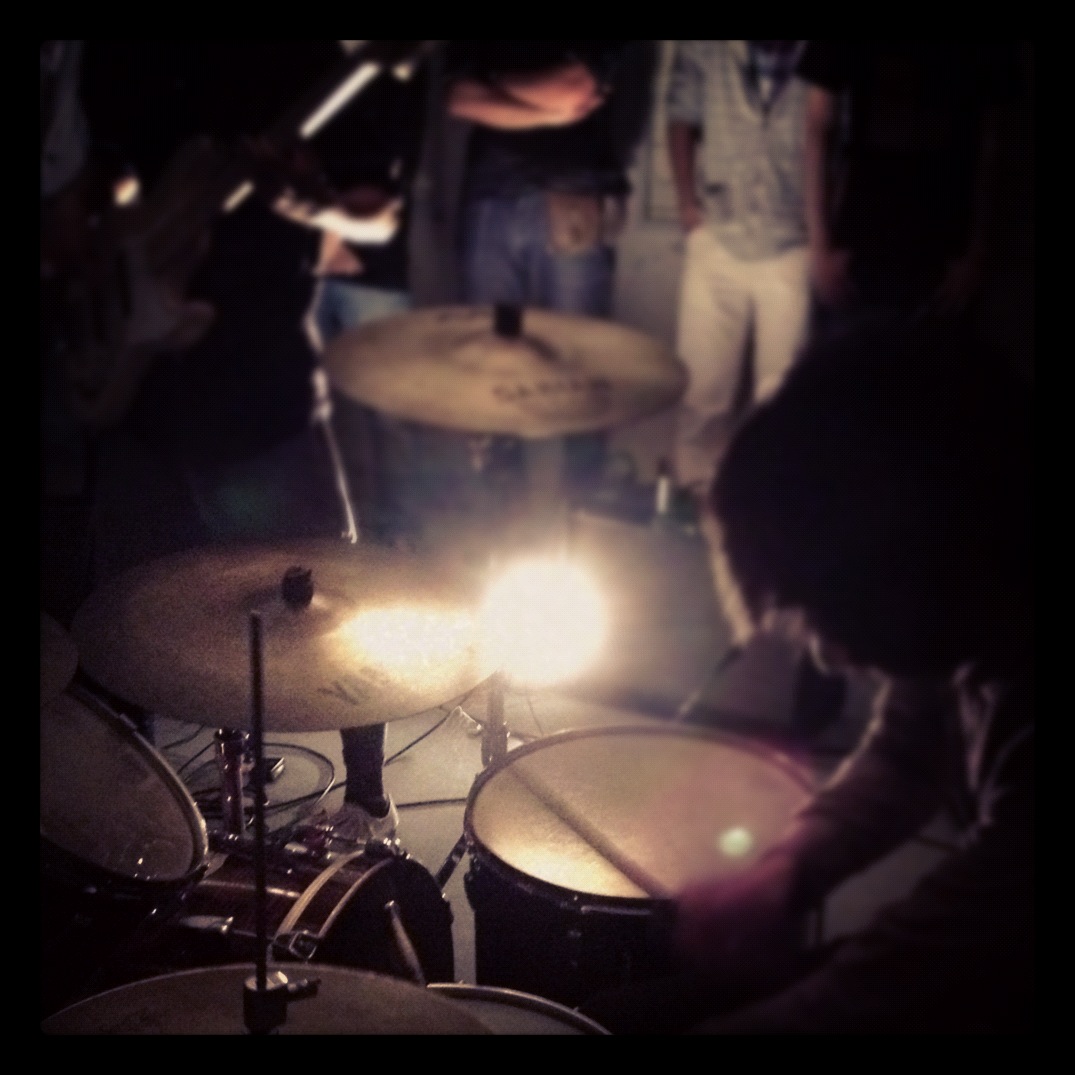I did my CIP through a volunteer agricultural organization called Mori No Megumi, or “Blessing of the Forest”, where I worked both on small vegetable plots in northern Kyoto and larger, more remote rice fields in the mountains east of Kyoto. What kind of activity we did varied every time we went there. The first time we did rice harvesting which was a really great first experience since I hadn’t ever worked with rice before. Moreover, the work required conversations about exactly how the rice should be cut, bundled together, and then put through the machine. On other occasions, we fertilized cabbages, cut weeds, and sorted rice. Even activities which sound like they would be boring, like hand sorting rice, turned out to offer their own unique rewards such as creating more opportunities for conversation. In fact, rice sorting gave me the chance to practice keigo as one of the volunteers spoke to me using honorifics. Thanks to recent class discussions I was able to understand her pretty easily and then follow her shift to less formal speech. It also provided a chance to reflect on what sorts of situations polite speech should be used in since I would have never expected someone to use keigo when speaking to me since the volunteer group was pretty laid back.
「Institution」カテゴリーアーカイブ
Chang won Lee: Ultimate Frisbee Circle – Breeze
I originally planned on learning kyudo (Japanese archery) for my community involvement project, but ultimately decided to join Kyoto University’ ultimate frisbee club “Breeze” in hopes that this intramural sports circle would provide more opportunities for conversation with Japanese students (I definitely needed the exercise as well). Reflecting back on the semester that flashed by, this proved to be a great choice; I met wonderful people, improved my Japanese speaking, and learned more about Japanese culture. Though of course, this experience was not without its challenges.
A cultural difference I quickly realized was the attitude towards intramurals in Japanese universities. Unlike the more light-hearted and playful mood that surrounds the activities of US intramural clubs, Breeze’s practices were in comparison carefully regimented and serious. Each practice, all members performed basic training exercises then split into the men and women’s team to work on team-specific drills and exercises. With every practice matches followed a round of discussion in which the senior members taught junior members the finer points of the game. While this approach to intramural sports did not mean the team was strictly competitive, the members’ attitudes made the purpose clear that the practice was not solely to have fun. Hence, my lack of experience became the biggest obstacle that inhibited my involvement within Breeze. Even freshmen players, with already five months of practice under their belt, had developed into skilled players while I still had to learn the basics. Due to this skill gap, I was unable to participate in practice matches and at times practiced separate from the main group of members.
While I could not fully integrate myself into the activities of Breeze and its members, joining Breeze was a wonderful experience as this provided plenty of opportunities to practice my Japanese speaking skills. Breeze has over 30 members and there were always opportunities to engage in quick conversations with different members. Though, I became particularly closer with the managers for the men’s team of Breeze. My exclusion from practice matches actually contained its upside as this provided lengthy windows of time that I could fill by chatting with the team managers. These conversations undoubtedly led to the most memorable conversations during my time at Breeze. In one conversation, the manager and I discussed possible reasons why the system of day light savings was not used in Japan. Of course, as with all conversation topics that entered a realm that required terms outside the commonly used, everyday vocab, this conversation inevitably led to some use of the dictionary and hand gestures. In the end, my time in Breeze allowed me to further increase my knowledge of Japanese culture and improved my speaking skills. I even acquired another unexpected skill: remembering Japanese names (which I probably learned a bit too late).
While short, Breeze was indeed a memorable experience; the club is filled with nice, sincere people and I greatly enjoyed the conversations I shared with them. I even developed a greater interest for the game of ultimate frisbee and plan to join an ultimate frisbee club at Penn once I return to the United States.
ヒュー・タラ:KIXSや会話サークル
秋学期のはじめに、アニメサークルや京都アニメーションなど、たくさんのところへ「見学させて頂けませんか」というメールを送ってみましたが、返事が来なく、結局国際交流に関するCIPをやることにしました。今CIPとしてやっているのは、KIXSという京都大学の国際サークルを参加することとEJKGという英語・日本語の会話グループを運営するのを手伝うことです。
KIXSでは毎週の水曜日に京大で食堂会が行われるのですが、週一回放課後に通っています。たくさん日本人と知り合って、飲み会やパーティにさそわれるので、なかなか良い交流ができそうな感じです。会話サークルは、毎週の木曜日に行います。日本人とも外国人とも会うことができて、運営がアメリカでやっていたサークルでの任務と似ているので、楽しんでしています。これからこの二つの活動で日本人の友達を増やして、日本語を練習していきたいと思います。
ヘンリー・マンテル:合気道の練習
私のCIPは合気道です。毎週月、木、土曜日に武道センターに行って、合気道を練習しています。合気道はとても楽しいけど、難しいです。合気道の先生はみんなに合気道の技法を見せて、補助教員と技法を実証します。先生はとても上手です。ぼくは若い人と練習します。でも、数人の合気道生の方が私より年を取っているけど、数人の合気道生は若いです。
練習毎に補助教員は私に新しい技法を教えます。いつも技法はたいへんだから、私たちは技法を何度も練習します。時々、上級生は私たちを手伝います。ぼくの日本語は上手じゃないけど、たいてい日本人の合気道生と話してみます。年上の人親切で、いろいろ助けれくれます。
ゲイブ・ベッカーマン:京都大学国際交流サークル (KIX)
私はCIPとして、最初は差別や人権問題に関する非営利団体でボランティアしようと思いましたが、色々な所にメールしてみても、返事が来ず、あまりボランティアする機会がなさそうでした。それで、スペイン語の能力を生かす活動も楽しそうと思い、大阪にあるスペイン語教室に連絡しましたが、そこでも活動する機会がないみたいでした。
第一週目にKIXについて聞きましたが、あまり国際交流サークルには興味がありませんでした。なぜかとういうと、メンバーに英語で話しかけられたり、あまり日本語を練習する機会にならないかと思いました。しかし、 CIPの探しがうまくいかなかったので、一回でもKIXに参加してみることにしました。KIXでは、毎週、京都大学の食堂に食事会が行われています。晩ご飯を食べながら、メンバーと会い、楽しい会話をしました。最初の食事会で、漫才がとても好きなメンバーに会え、食べながら笑っていました。それで、英語を勉強したことがあるメンバーがいましたが、英語以外の外国語を勉強している人が多く、一回も英語で話すこともなく、日本語たくさん喋れました。あまり同志社の日本人の学生に会えるチャンスがありませんが、KIXを通して色々な日本人の友達が作れそうです。また参加するのを楽しみにしています。
ジョー・ラックマン:京都大学院テニスサークル
京都大学の大学院テニスサークル
今学期、私は京都大学の大学院生テニスサークルに参加している。同志社大学の交流会で一人のメンバーと知り合って、次の練習に誘われた。最初から気に入ったから、毎週一回はみなと練習するようになった。練習場所は御所の近くだから、ぜんぜん遠くない。一つの気づいたことは、毎週グループのメンバーが変わることだ。たまに来る人もいれば、めったに来ない人もいる。もちろん、毎週来る人もいるけど、そのたびグループがかなり違う。全員合わせて、35人ぐらいと聞いてるけど、毎週15人ぐらいが練習しに来る。人間関係が最優先だったら多い方がいいけど、練習したいなら結局少ない方がいい。
二週間前、コトクロスの近くのレストランでサークルの新学期の飲み会が行われた。まるで別のサークルみたいで、半分以上は知らない人だった。確かに国際交流の飲み会と違って、唯一の外国人として会話は聞き取りにくかったけど、頑張るしかなかった。違う舞台でサークルの人と話しをする機会として価値があった。
このサークルのレベルは丁度良いと思う。なぜかというと、僕はちょっと目立つけど、一番強い選手ではない。文化的に一つの不安なところは私は一番若いが、テニスの初心者ではないことだ。むしろ、アメリカで初心者の先生をしていた。グループのメンバーとして、みなが上達してほしいけど、他の人にアドバイスをあげてもいいか分からない。練習のとき、みな一所懸命練習をしていると思うけど、このグループの先輩は技術を教えていなさそう。僕はとりあえず何もいわないこととにした。
面白いことに、ダブルスの練習のとき、僕はよくパートナーを励ますためにポイントを勝ったら親指を上げるが、最近他のサークルのメンバーズはわざと真似をしているそうだ。僕の反応はちょっと面白く見られているようだ。日本にいる間、このグループの人々と仲良くなるのを楽しみにしている。
エイミー・シン:エンジェルネット
初めまして。ペン大のエイミーシンと申します。私 はエンジェルネットというところでボランティエをしています。エンジェルネットは 子供が来て、おやつをたべたり、宿題をしたり、あそんだりするところです。そして、毎週私は子供の手伝いをしています。
私はいつも二時半にエンジェルネットのビルに入って、靴を脱いで部屋に入ります。子供は私を見ると笑らいます.その後で子供はおやつを食べます。おやつは 私は子供に水をあげます。おやつの後でみんな歌を歌って、とてもかわいいです。歌はたくさんあるんです。例えばおやつの歌とかどんぶりの歌があります。その後で、子供はいっしょにレゴとドミノで楽しそうに遊びます。私は五時半まで子供とゲームをします。金曜日は散歩をする日です。散歩をする時は、エンジェルネットの外の商店街でします。ほかの人は子供達に「こんにちは!」とか「かわいい!」と言います。いつもとてもおもしろいと思います。五時半に私はエパートに帰ります。
これが私の普通のスケジュールですが、毎回同じというわけではありません。時々私はほかのことをします。例えば、時々エンジェルネットのちらしをたたんで、封筒に入れます。この仕事はおもしろくないと思います。でも、エンジェルネットにお客さんを引きつけるために、ちらしを配った方がいいです。
エンジェルネットに三人の先生がいるから、時々先生と話します。二人は英語を話せないから、日本語で話します。でも、一人は英語を勉強しているから、先生の英語の勉強のために英語で話します。子供は時々英語を話したり、時々日本語を話したります。でも、子供はとても早く話して、関西弁だから、時々全然分かりません.そのような時に、私は微笑んで、「分かりません」と言って、新しい話題について話します。でも、私はCIPを参加して日本語を習いました。だから、嬉しいです。私のブログを読んでくださってありがとうございました。
ジェローム・モラスキー:EMBG(京大のロック音楽のサークル)
CIPの説明を初めて聞いた時、京大とか、同志社大学のサークルに入るのはこんなに難しいと考えられませんでした。一ヶ月間半ぐらい前インタネットで同志社大学のライラック・レインボーズと言う音楽サークルについて読みました。でも、そのサークルにメールを出しても、返事は来ませんでした。それを受けて、外のサーックルを捜しました。ネクサスの言うサークルにメールを出しましたが、結果は同じでした。
その週末、パーティーでライラック・レインボーズのメンバーに会いましたが、やっぱり入るのは多分難しいと言っていました。それに、その人は「普通のミーティングは京田辺キャンパスである」と言いました。京田辺は遠くて 、不便だから、ライラック・レインボーズに入るのをやめました。
でも、僕と一緒に入りたかったKCJSの学生の友達がZETSと言う京都大学の音楽サークルのメンバーの友達を作って、その京大の学生は「今週の水曜日、ZETSのミーティングに来て見てください」と言いました。一緒に行ったら、ZETSの皆さんは親切で、私たちは同じ興味を持っていたから、すぐ何人もの友達を作りました。ZETSのリーダーと相談した後、係の人が「今は入れるかどうか分かりません」と言いましたが、外のEMBGと言う音楽サークルのリーダーを紹介してくださいました。その人は、「来週もう一度来てください」と言って、私たちはうれしくなりました。
次の週の金曜日もう一度行って、その時EMBGの皆さんといろいろな事について話しました。聞いたら、「ええ、もちろん入れるよ」と答えてくれてよかったです。そのミーティングが終わったら、みんなでお好み焼きのレストランに行って、おいしい物を食べました。食事が終わった時、地下鉄への道が分からなかったが、EMBGのメンバーが車で連れて行ってくださいました。次の金曜日、EMBGのライブに行きました。EMBGで、別のバンドがありませんが、何かを演奏したかったら、外の楽器を弾いている人々と一緒にその曲を練習してもらえます。今回、二つのバンドが演奏しました。曲が全然知らなかったけど、演奏していない学生がモッシュピットとか、ダンスもしていたから、やっぱりその経験はすごく楽しかったです。小さい教室であったし、とてもうるさかったから、終わったらあんまり聞こえなくなりました。その時も、いろいろな友達が作れてよかったです。
外のライブで演奏をしたいので、今時間があれば練習しています。今まで一人だけで弾いた事がありますが、バンドで演奏するのも楽しそうです。
エアロン・ブラウニング:ロック音楽のライブのサークル
 日本に来る前に、KCJSのCIPとしてロックなどのエレキ音楽のサークルに入ることにしました。その決定には理由がたくさんあります。まず、中学の時から、ドラムが叩いています。高校生の時はThe Kindergarten Circusというガレージバンドとナッシュビルで演奏をたくさんしました。それで大学に入学するまでに、もう若い人のロック音楽の文化に興味を持つようになりました。その間に、日本語のクラスを取り始めました。二回生の秋、この二つの興味を合成して、日本のグループサウンズについて論文を書きました。それから、学究的な基本を作りました。僕にとって大切だし、楽しいし、面白いので、研究や、経験を、続けたかったんです。
日本に来る前に、KCJSのCIPとしてロックなどのエレキ音楽のサークルに入ることにしました。その決定には理由がたくさんあります。まず、中学の時から、ドラムが叩いています。高校生の時はThe Kindergarten Circusというガレージバンドとナッシュビルで演奏をたくさんしました。それで大学に入学するまでに、もう若い人のロック音楽の文化に興味を持つようになりました。その間に、日本語のクラスを取り始めました。二回生の秋、この二つの興味を合成して、日本のグループサウンズについて論文を書きました。それから、学究的な基本を作りました。僕にとって大切だし、楽しいし、面白いので、研究や、経験を、続けたかったんです。
クラスメートがしたいCIPのプロジェクトを決める中、ジェロムという同じクラスにいる友達と喋るようになりました。同じ情熱や目的があるから、一緒にサークルを探すことにしました。いろいろなむずかしさのせいで、すぐに見つかられ買ったけど、僕らは頑張って、「たく」という京大の大学生に手伝ってもらいました。ある日、「たく」さんと遊びに行く時に、僕がZETSのことを話すと、「たく」さんはZETSのメンーバーの友達がいると言いました。つぎの日、「ひろ」さんという人にメールをもらいました。メールで、「ひろ」さんは京大で次のZETSミーティングに誘ってくれました。 そして、先月のある日、木曜日に、僕とジェロムさんはそのビルに行ってみることにしました。4共という京大のビルには、毎週の木曜日と金曜日にかっこいい音楽をする人でいっぱいになります 。そこで、「ひろ」さんと会って、他のZETSというサークルのメンバーと喋って、ちょっと知り合いになりました。賑やかでわくわくしました。しかし、ZETSに入るのはちょっと難しいので、他のEMBGというサークルにはいることになりました。両方のサークルが同じビルで集まるから、大したことはなかったです。 本当に、その初めての経験はとても楽しかったです。
その時以来、4回EMGBとZETSのミーティングやエベントに参加しました。ライブ(エレキ演奏)をたくさん見ました。自分でリッキーというEMBGのメンバーと2曲演奏しました!今まで、それをするのはすごい事で、学期の将来を絶対に楽しみにしています。
シュウ・ユエイ:京大ソフトテニスサークル
CIPを決める時には、過去経験した事がある内容のサークルに注目しました。特に京大のオーケストラやテニスなどのサークルに興味を持ち、少し調べてみました。オーケストラに参加する場合に備えてトランペットのマウスピースをアメリカから持ってきましたが、テニスラケットだけは大きすぎて、とりあえずアメリカに置いてきました。しかし、オーケストラの方は楽器を借りないといけなくて、一学期しか参加できなくて、半年だけで戻ってもオケの皆さんに迷惑になるかと思いながら授業で先生に相談しました。
その後わずか一週間後に私は西院テニスコートで京大ソフトテニスサークルの練習に参加させてもらいました。ラケットまで貸してもらって、サークルの皆さんはとても優しかったです。私はもうレギュラーの様に見られて、紹介などはありませんでした。後から見ると、サークルには毎日30人ほど練習に参加して、今でもまだ会った事も無い人たちが毎週数人会います。その理由は、このサークルは試合やトーナメントなどはなくて自分の為に練習するので、毎週参加する人はその週が暇な人だったということなのでしょう。
ソフトテニスは難しいですが、この一ヶ月間で大分上達できたと思います。サークルのおかげで京大と同志社の外の生徒さんに会う機会もいただいて、本当にうれしいです。毎週練習に参加する時は、「今日はまた新しい生徒達に会えるかな?」と思いながら楽しんでいます。


